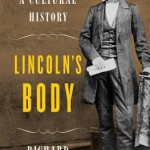 Historian Richard Wightman Fox employs a unique concept in discussing Abraham Lincoln: Lincoln’s body. His body – the physical, the figurative, the aura, and the memory – is used to trace how he was perceived at the time and during several periods since then to the present day. In doing so, Fox has successfully provided a mirror into not only Abraham Lincoln, but ourselves.
Historian Richard Wightman Fox employs a unique concept in discussing Abraham Lincoln: Lincoln’s body. His body – the physical, the figurative, the aura, and the memory – is used to trace how he was perceived at the time and during several periods since then to the present day. In doing so, Fox has successfully provided a mirror into not only Abraham Lincoln, but ourselves.
The book is split into three main parts ostensibly covering three broad concepts and also three broad time periods. The Public Body (1840-1865) focuses mostly on how Lincoln’s physical attractiveness (or lack thereof) was used both to promote and dismiss him during his political lifetime. These chapters also discuss his initial martyrdom, impact of the lack of any “last words,” and bodily degradation during the funeral.
The second part, The Enshrined Body (1865-1909), examines the memorialization of Lincoln, the use of him as a symbol, and the “reinterpretation” of him such that he was either for or against political goals, including “black emancipation” and “white reunion.” This section gets us up to the centenary of his birth.
In the final part, The National Body (1909-2015), Fox looks at the various stages of development of what could best be termed the Lincoln “cult” and “anti-cult.” He looks at the development of two memorials that solidify the “cult” (Lincoln Memorial and Sandburg’s Lincoln), and also at Lincoln has been depicted on the screen. Most importantly, Fox does an excellent job looking at Lincoln’s role (and sometimes lack of role) in the Civil Rights era. His discussion of Martin Luther King is one of the best parts of the book. Finally, this part spends considerable time on the more recent cinematic (and Disney) treatments of Lincoln, with a clear appreciation of the Spielberg/Kushner/Day Lewis movie, “Lincoln.”
The writing is fluid and readable. The use of the “body” thread throughout the book is well done – enough to carry the theme without making it groan from its own weight. But the real value of the book is in how Fox reflects the body of Lincoln in all its senses back on our changing views of liberty, race, and democracy over the course of the 150 years since Lincoln’s body made that last long railroad trip back to Springfield.
David J. Kent has been a scientist for over thirty years, is an avid science traveler, and an independent Abraham Lincoln historian. He is the author of Tesla: The Wizard of Electricity and the e-book Nikola Tesla: Renewable Energy Ahead of Its Time. He is currently writing a book on Thomas Edison.
Follow me by subscribing by email on the home page. And feel free to “Like” my Facebook author’s page and connect on LinkedIn. Share with your friends using the buttons below.










